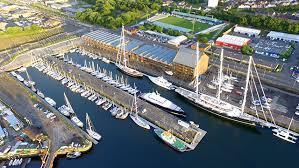At the time of development, James Watt Dock was believed to be the only dock on the Clyde where large ships could be kept afloat in all tidal states. However, development of the dock was not economical. The original budget was estimated at £242,885 5s 3d, however, the actual outlay for 1886 was £634,343 8s 3d (or £850,000 including land price).
The justification for such an undertaking (and substantial debt) was the large and rapidly increasing volume of trade that passed from the Clyde to Glasgow. At the time it was thought that such a facility would enable Greenock to benefit from the larger ships that were used for trade and passenger traffic that were forced to navigate the upper reaches of the Clyde in any condition below high tide.
For a period of time this belief remained true and allowed Greenock to enter a period of unprecedented expansion. In conjunction with basic industries (such as sugar refining and shipbuilding), the boom in trade fueled significant development that led to the city’s growth.
Other docks that make up Greenock ports include; West Harbour, East India Harbour, Victoria Harbour, Albert Harbour, Princes Pier, West Quay, Customhouse Quay, Garvel Graving Dock and Great Harbour. Some of these ports and docks are no longer functioning as working harbors and in fact some have been filled in to expand waterfront development.
The large cantilever crane or Titan Cantilever Crane visible as you approach the pier was built in 1917 by Sir William Arrol & Co.
The 150t structure is a Category A structure (Historic Scotland Building ID: 34175) and is one of 4 remaining in Scotland (40 were built by Arrol & Co and sent around the world).
Nearly two-thirds of the British tonnage in iron steamers was produced on the Clyde with many of the ships built and launched in the many yards between Port Glasgow and Greenock.
Demand for Clyde-built ships peaked before the outbreak of World War I with a steady decline in completions and launches. In 1955, 27 new ships were launched from Inverclyde yards, but by 1975 this figure had dropped to only 10 days. Today the last remaining yard on the lower Clyde is Ferguson, established in 1903.
The first commercial sugar refinery was opened in Greenock in 1850, and by 1864 nearly a quarter of Britain’s sugar refineries were located in Greenock and Port Glasgow. By the late 19th century the sugar trade was booming with about 400 ships arriving at Greenock’s ports each year from the Caribbean. The most famous of these refineries, Tate & Lyle, was founded in 1921 and operated successfully in the city until its closure in 1997. The large warehouse at James Watt Dock Marina was used to store raw and processed sugar-this Category A-listed facility is known locally as the “Sugar Shed.”
James Watt (1736-1819) is the most famous person born in the Inverclyde area. His discoveries and inventions helped make Britain the world’s leading industrial power. His work ranged from patenting letters and designing copiers to improvements made at Greenock Harbour, but his name is best known through his work on steam power and the industrialization of manufacturing processes. More information about James Watt can be found by visiting the City of Inverclyde’s Local History and Heritage pages or by visiting the McLean Museum & Art Gallery.









